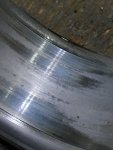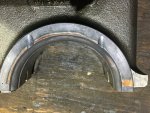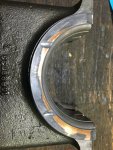Definitely looks like some wear, but is that bad? I won't say yes and I won't say no. I don't have the expertise to say if that crank needs attention or not, but if that engine ran smooth before you dug into it,I have no reason to believe it won't continue to run smoothly once it's running again. That could be something that has been like that for who knows how long or how long of a period to wear to that point, ect. If there's no definitive answer, my only suggestion is to just run new bearings where you can, use good oil, and keep it clean with regular oil changes along with good filters, keeping the rpms within safe operating range.
I do know that the bearings have a small oil passage and that could be something easily plugged or difficult for thick oil to flow until fully warmed, so this may shed some light on how important it is to run good, clean oil, and also why cold starts where the engine fires up and revved to a high rpm right away can be a bad thing not just for the turbo but on the bearings as well

I honestly wouldn't be too concerned over it if there was never a suspicion with a bearing to begin with, but I would note it somewhere and that cylinder(s) even pictures, so if there ever is a suspicion, or another rebuild, you have something to reference to gauge the amount of wear there is.
At least if you decide to run it as is with the old bearings, you know it's all accessible from the bottom, so it's not like you can't go back sometime next year and replace all the bearings or if you find another crank in good condition, plan for a future lower end rebuild. I just don't recall if the motor has to be lifted or not to remove the crank should it come down to that.
Hopefully a multi-fuel guru who has seen some cranks in their time can shed some light on that, so no work is done in vien.




